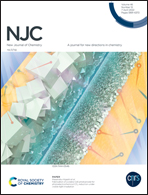The use of electrostatic potential at nuclei in the analysis of halogen bonding†
Abstract
The molecular electrostatic potential (MESP) at the nuclei of a large heterogeneous set of halogen bonded complexes calculated at the M06-2X/aug-cc-pVTZ level of theory is studied. Halogen bond formation leads to a positive change in MESP at the donor atom (ΔVn-D), while the acceptor atom shows a corresponding negative change (ΔVn-A). Furthermore, ΔΔVn, the difference between ΔVn-D and ΔVn-A, showed a strong linear relationship with the halogen bonding interaction energy (Eint) with R2 = 0.951 for the whole set of complexes. Hence, the halogen bond is interpreted as a weak electron donor–acceptor interaction (eDA) wherein a base partner (D) donates electron density to an acceptor partner (A). The study confirms that MESP at the nuclei of interacting atoms is a very sensitive measure of intermolecular interactions and even very weak halogen bonded systems can be interpreted in terms of the subtle variation that occurs in MESP due to bond formation. Since MESP is a real physical property that can be determined experimentally, its linear relationship with the bond energy suggests that MESP data can be used as ‘clear evidence of bond formation’, a criterion that the IUPAC recommends to define a halogen bond.



 Please wait while we load your content...
Please wait while we load your content...